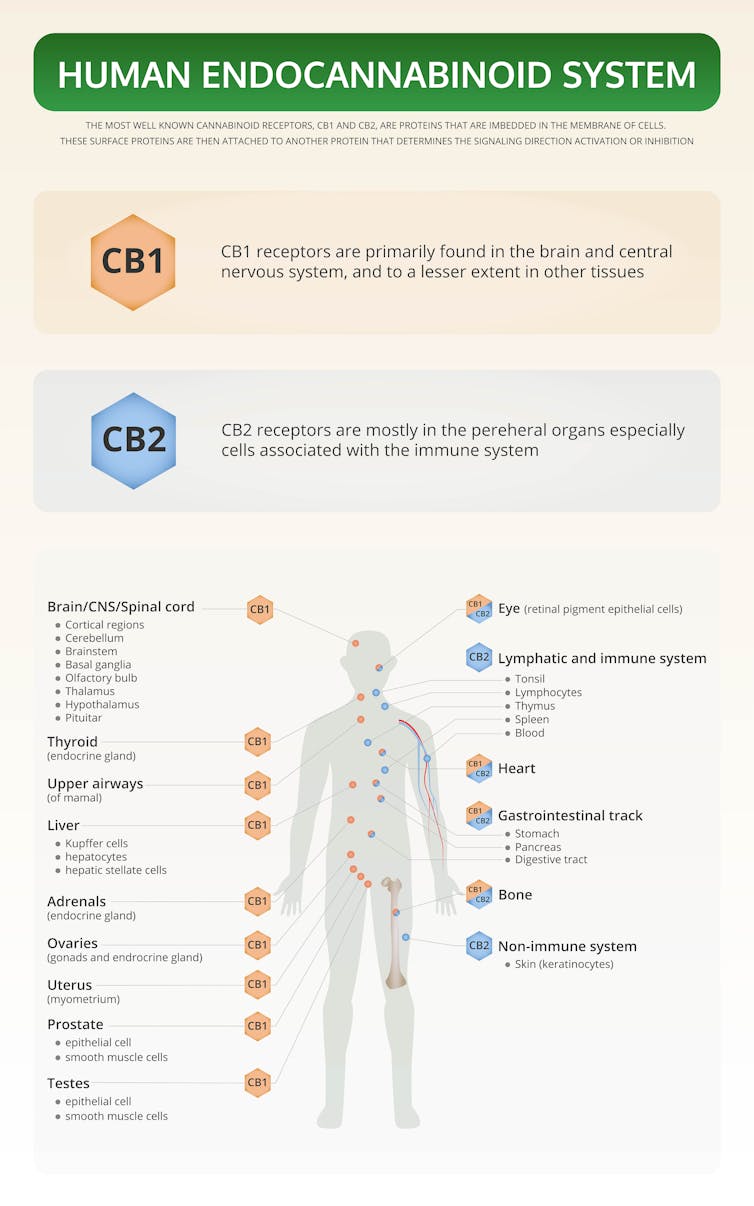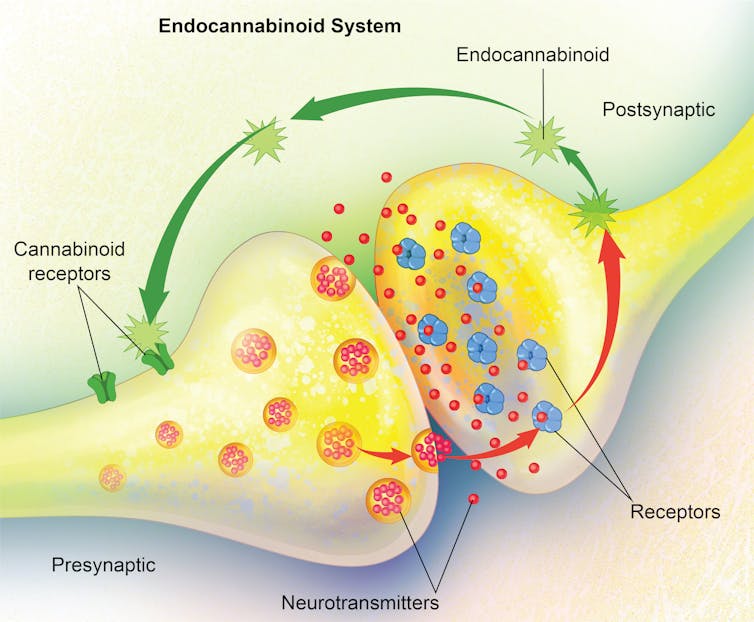People produce endocannabinoids – similar to compounds found in marijuana – that are critical to many bodily functions
Over the past two decades, a great deal of attention has been given to marijuana – also known as pot or weed. As of early 2023, marijuana has been legalized for recreational use in 21 states and Washington, D.C., and the use of marijuana for medical purposes has grown significantly during the last 20 or so years.
But few people know that the human body naturally produces chemicals that are very similar to delta-9-tetrahydrocannabinol, or THC, the psychoactive compound in marijuana, which comes from the Cannabis sativa plant. These substances are called endocannabinoids, and they’re found across all vertebrate species.
Evolutionarily, the appearance of endocannabinoids in vertebrate animals predates that of Cannabis sativa by about 575 million years.
It is as if the human body has its own version of a marijuana seedling inside, constantly producing small amounts of endocannabinoids.
The similarity of endocannabinoids to THC, and their importance in maintaining human health, have raised significant interest among scientists to further study their role in health and disease, and potentially use them as therapeutic targets to treat human diseases.
THC was first identified in 1964, and is just one of more than 100 compounds found in marijuana that are called cannabinoids.
Endocannabinoids were not discovered until 1992. Since then, research has revealed that they are critical for many important physiological functions that regulate human health. An imbalance in the production of endocannabinoids, or in the body’s responsiveness to them, can lead to major clinical disorders, including obesity as well as neurodegenerative, cardiovascular and inflammatory diseases.
We are immunologists who have been studying the effects of marijuana cannabinoids and vertebrate endocannabinoids on inflammation and cancer for more than two decades. Research in our laboratory has shown that endocannabinoids regulate inflammation and other immune functions.
What is the endocannabinoid system?
A variety of tissues in the body, including brain, muscle, fatty tissue and immune cells, produce small quantities of endocannabinoids. There are two main types of endocannabinoids: anandamide, or AEA, and 2-arachidonoyl glycerol, known as 2-AG. Both of them can activate the body’s cannabinoid receptors, which receive and process chemical signals in cells.
One of these receptors, called CB1, is found predominantly in the brain. The other, called CB2, is found mainly in immune cells. It is primarily through the activation of these two receptors that endocannabinoids control many bodily functions.
The receptors can be compared to a “lock” and the endocannabinoids a “key” that can open the lock and gain entry into the cells. All these endocannabinoid receptors and molecules together are referred to as the endocannabinoid system.
The cannabis plant contains another compound called cannabidiol, or CBD, which has become popular for its medicinal properties. Unlike THC, CBD doesn’t have psychoactive properties because it does not activate CB1 receptors in the brain. Nor does it activate the CB2 receptors, meaning that its action on immune cells is independent of CB2 receptors.

About time/iStock via Getty Images Plus
Role of endocannabinoids in the body
The euphoric “high” feeling that people experience when using marijuana comes from THC activating the CB1 receptors in the brain.
But when endocannabinoids activate CB1 receptors, by comparison, they do not cause a marijuana high. One reason is that the body produces them in smaller quantities than the typical amount of THC in marijuana. The other is that certain enzymes break them down rapidly after they carry out their cellular functions.
However, there is growing evidence that certain activities may release mood-elevating endocannabinoids. Some research suggests that the relaxed, euphoric feeling you get after exercise, called a “runner’s high,” results from the release of endocannabinoids rather than from endorphins, as previously thought.
The endocannabinoids regulate several bodily functions such as sleep, mood, appetite, learning, memory, body temperature, pain, immune functions and fertility. They control some of these functions by regulating nerve cell signaling in the brain. Normally, nerve cells communicate with one another at junctions called synapses. The endocannabinoid system in the brain regulates this communication at synapses, which explains its ability to affect a wide array of bodily functions.
The elixir of endocannabinoids
Research in our laboratory has shown that certain cells of the immune system produce endocannabinoids that can regulate inflammation and other immune functions through the activation of CB2 receptors.
In addition, we have shown that endocannabinoids are highly effective in lessening the debilitating effects of autoimmune diseases. These are diseases in which the immune system goes haywire and starts destroying the body’s organs and tissues. Examples include multiple sclerosis, lupus, hepatitis and arthritis.
Recent research suggests that migraine, fibromyalgia, irritable bowel syndrome, post-traumatic stress disorder and bipolar disease are all linked to low levels of endocannabinoids.
In a 2022 study, researchers found that a defect in a gene that helps produce endocannabinoids causes early onset of Parkinson’s disease. Another 2022 study linked the same gene defect to other neurological disorders, including developmental delay, poor muscle control and vision problems.
Other research has shown that people with a defective form of CB1 receptors experience increased pain sensitivity such as migraine headaches and suffer from sleep and memory disorders and anxiety.

Carolina Hrejsa, CMI/iStock/Getty Images Plus via Getty Images
The likeness between marijuana and endocannabinoids
We believe that the medicinal properties of THC may be linked to the molecule’s ability to compensate for a deficiency or defect in the production or functions of the endocannabinoids.
For example, scientists have found that people who experience certain types of chronic pain may have decreased production of endocannabinoids. People who consume marijuana for medicinal purposes report significant relief from pain. Because the THC in marijuana is the cannabinoid that reduces pain, it may be helping to compensate for the decreased production or functions of endocannabinoids in such patients.
Deciphering the role of endocannabinoids is still an emerging area of health research. Certainly much more research is needed to decipher their role in regulating different functions in the body.
In our view, it will also be important to continue to unravel the relationship between defects in the endocannabinoid system and the development of various diseases and clinical disorders. We think that the answers could hold great promise for the development of new therapies using the body’s own cannabinoids.
For all the latest Health News Click Here
For the latest news and updates, follow us on Google News.
